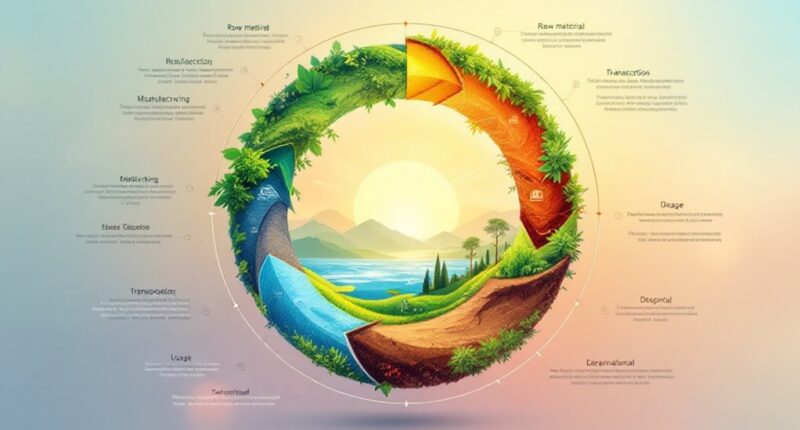Life Cycle Assessment (LCA) is like a backstage pass to understanding a product’s environmental journey—from its raw materials to the moment it hits the landfill. It evaluates impacts like global warming and resource depletion, following strict standards to help companies make eco-conscious decisions. Think of it as a report card for sustainability, shining light on eco-labeling and transparency. It’s the ultimate tool for brands to boost their reputation and tackle climate change. Want to discover more about its benefits?

In today’s environmentally conscious world, the phrase “Life Cycle Assessment” (or LCA, for those in the know) often pops up like a catchy tune at a party, enticing many to dance along with the rhythm of sustainability. LCA is not just a buzzword; it’s a systematic method that evaluates the environmental impacts of products and services from the cradle to the grave. Imagine tracing a product’s journey, from raw material extraction to disposal, like following a soap opera plot twist that keeps you guessing.
Life Cycle Assessment: the ultimate sustainability journey, tracing products from cradle to grave like a captivating soap opera.
The process of LCA involves several key stages. It begins with goal and scope definition, setting objectives and boundaries—think of it as deciding what flavor of ice cream to scoop. Next comes the life cycle inventory analysis, where data on inputs and outputs is collected like a meticulous hoarder gathering treasures. Then, there’s the life cycle impact assessment, which evaluates potential environmental impacts, revealing the hidden drama behind resource use, emissions, and effects on nature. Finally, interpretation analyzes the results, providing recommendations for improvement, much like a coach reviewing game footage to strategize for victory. Life Cycle Assessments are standardized and guided by international standards such as ISO 14044, ensuring consistency and reliability in the evaluation process. Additionally, understanding LCA impact categories helps companies reduce their environmental footprint by targeting key hotspots.
LCA can spotlight various environmental impact categories, including global warming potential (ever heard of a carbon footprint?), ozone depletion, and resource depletion. It’s like a report card for sustainability, helping companies make informed decisions. Applications of LCA range from product development to strategic planning and even eco-labeling, enhancing brand reputation through transparency.
However, the road to LCA isn’t without hurdles. Challenges include data availability issues and the complexity of defining system boundaries, akin to solving a Rubik’s Cube while blindfolded. Yet, emerging trends, such as integrating social assessments and utilizing big data, are paving the way for smoother assessments. As the world shifts towards circular economy principles, LCA stands as a beacon for informed, sustainable decision-making, inviting everyone to join the dance of responsible consumption.
Frequently Asked Questions
How Long Does a Typical LCA Study Take to Complete?
When pondering the duration of a typical study, one might imagine a leisurely stroll through a park. However, in reality, the timeline can stretch from a brisk 2 months for simpler projects to a marathon 12 months for the more intricate ones.
Factors like data availability and complexity play a vital role, making the process akin to assembling IKEA furniture—sometimes straightforward, often a puzzle that requires patience and a little humor.
What Are the Main Software Tools Used for LCA?
When it comes to analyzing environmental impacts, several software tools stand out like stars in a tech-filled night sky. SimaPro and GaBi are like the heavyweights, known for their detailed insights. Meanwhile, OpenLCA offers a free ticket to the party for those on a budget.
For the construction crowd, OneClickLCA is a favorite. Emerging platforms like Makersite blend cost and sustainability, proving that eco-friendliness can be both smart and stylish
Can LCA Results Vary by Region or Country?
Results can vary wildly by region, much like how pizza tastes different in New York compared to Chicago. Factors like energy sources, regulations, and even how buildings are measured can skew outcomes.
For instance, a country’s energy mix might lead to markedly different emissions calculations. It’s as if each region plays by its own set of rules, making comparisons tricky. So, while numbers may dance around, understanding them requires a keen eye for local nuances.
How Can Companies Implement LCA Findings Effectively?
Companies can effectively implement findings by weaving them into their daily operations. They should form cross-functional teams to tackle insights, much like assembling a superhero squad for tackling environmental challenges.
Developing decision frameworks that prioritize sustainability is key, as is redesigning products to minimize their environmental impact. Collaborating with suppliers can further enhance sustainability, creating a ripple effect.
Finally, sharing results transparently can boost brand reputation, making customers feel like they’re part of the eco-friendly journey.
Are There Certifications Available for LCA Studies?
The quest for certifications in environmental assessments is a bit like hunting for the perfect avocado—tricky but rewarding. Various programs exist, like ACLCA’s LCACP and ILCA’s Professional Certification, each offering a unique spin on LCA expertise.
While these certifications boost credibility and career prospects, they come with challenges, such as inconsistent recognition and evolving standards. So, aspiring eco-warriors, be prepared to navigate this certification jungle with a discerning eye









